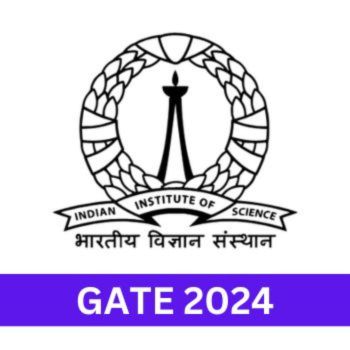If you are a GATE Aspirant for the CSE field, here are the details of the GATE 2024 Syllabus of CSE.
The Graduate Aptitude Test in Engineering (GATE) is an all-India examination conducted across the country jointly by IISc and seven IITs on behalf of the National Coordinating Board (GATE), Ministry of Education, Government of India. Admission to postgraduate programmes with the Ministry of Education and some other government scholarships/assistantships at engineering colleges/ institutes in the country are open to those who qualify through GATE.
Combinational and sequential circuits. Minimization. Number representations and computer arithmetic (fixed and floating point).
Machine instructions and addressing modes. ALU, data path and control unit. Instruction pipelining, pipeline hazards. Memory hierarchy: cache, main memory and secondary storage; I/O interface (interrupt and DMA mode).
Programming in C. Recursion. Arrays, stacks, queues, linked lists, trees, binary search trees, binary heaps, graphs.
Searching, sorting, hashing. Asymptotic worst-case time and space complexity. Algorithm design techniques: greedy, dynamic programming and divide‐and‐conquer. Graph traversals, minimum spanning trees, shortest paths
Regular expressions and finite automata. Context-free grammars and push-down automata.Regular and context-free languages, pumping lemma. Turing machines and undecidability.
Lexical analysis, parsing, syntax-directed translation. Runtime environments. Intermediate code generation. Local optimisation, Data flow analyses: constant propagation, liveness analysis, common subexpression elimination.
System calls, processes, threads, inter‐process communication, concurrency and synchronization. Deadlock. CPU and I/O scheduling. Memory management and virtual memory. File systems.
ER‐model. Relational model: relational algebra, tuple calculus, SQL. Integrity constraints, normal forms. File organization, indexing (e.g., B and B+ trees). Transactions and concurrency control.
Concept of layering: OSI and TCP/IP Protocol Stacks; Basics of packet, circuit and virtual circuit switching; Data link layer: framing, error detection, Medium Access Control, Ethernet bridging; Routing protocols: shortest path, flooding, distance vector and link state routing; Fragmentation and IP addressing, IPv4, CIDR notation, Basics of IP support protocols (ARP, DHCP, ICMP), Network Address Translation (NAT); Transport layer: flow control and congestion control, UDP, TCP, sockets; Application layer protocols: DNS, SMTP, HTTP, FTP, Email.
| Paper Code | General Aptitude (GA) Marks | Subject Marks | Total Marks | Total Time (Minutes) |
|---|---|---|---|---|
| AE, AG, BM, BT, CE, CH, CS, CY, EC, EE, ES, EY, IN, MA, ME, MN, MT, NM, PE, PH, PI, ST, TF | 15 | 85 | 100 | 180 |
| AR [Part A + Part B1 or B2 (B1: Architecture or B2: Planning)] B1 or B2 can be selected during Exam. | 15 | 60 + 25 | 100 | 180 |
| GE [Part A + Part B1 or B2 (B1 – Surveying and Mapping or B2 -Image Processing and Analysis)] B1 or B2 can be selected during the Exam. | 15 | 55 + 30 | 100 | 180 |
| GG [Part A + Part B] (Section 1: Geology or Section 2: Geophysics) | 15 | 25 + 60 | 100 | 180 |
| XL (Section P + Any TWO Sections) Sections can be selected during the Exam. | 15 | 15 + (2 x 35) | 100 | 180 |
| XH (Section B1 + Any ONE Section) | 15 | 25 + 60 | 100 | 180 |
| AR [Part A + Part B1 or B2 (B1: Architecture or B2: Planning)] B1 or B2 can be selected during the Exam. | 15 | 25 + (2 x 30) | 100 | 180 |
| Particulars | Details |
|---|---|
| Examination Mode | Computer-Based Test (CBT) [will be conducted at select centres in select cities] |
| Duration | 3 Hours* |
| Number of Subjects (Papers) | 29 |
| Sections | General Aptitude (GA) + Candidate’s Selected Subject(s) |
| Type of Questions | (a) Multiple Choice Questions (MCQ) (b) Multiple Select Questions (MSQ) and/or (c) Numerical Answer Type (NAT) Questions |
| Questions for testing these abilities | (a) Recall (b) Comprehension (c) Application (d) Analysis & Synthesis |
| Number of Questions | 10 (GA) + 55 (subject) = 65 Questions |
| Distribution of Marks in all Papers EXCEPT papers AR, CY, EY, GG, MA, PH, ST, XH and XL | General Aptitude: 15 Marks + Engineering Mathematics**: 13 Marks + Subject Questions: 72 Marks = Total: 100 Marks (**XE includes Engineering Mathematics section XE-A of 15 Marks) |
| Distribution of Marks in papers AR, CY, EY, GG, MA, PH, ST, XH and XL | General Aptitude: 15 Marks + Subject Questions: 85 Marks = Total: 100 Marks |
| Marking Scheme | Questions carry 1 mark and 2 marks |
| Negative Marking | For a wrong answer chosen in a MCQ, there will be negative marking. For 1-mark MCQ, 1/3 mark will be deducted for a wrong answer. Likewise, For 2-mark MCQ, the 2/3 mark will be deducted for a wrong answer. No negative marking for Incorrect answer(s) to MSQ or NAT questions. |

